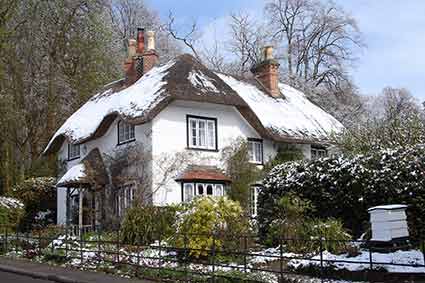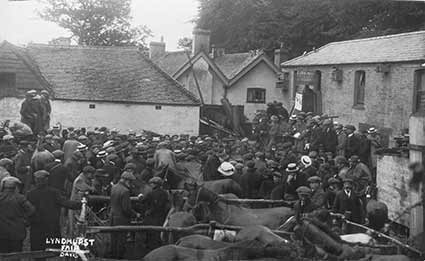Swan Green

Overlooked by picturesque thatched cottages, and the home of a well-used cricket pitch, it’s not surprising that Swan Green is one of the most photographed locations in the New Forest. Indeed, some of the earliest postcards of the area depict Swan Green, including the single-storey blacksmith’s forge that was present until the 1930s.
Before the introduction of the motor car, of course, blacksmiths were in great demand, particularly in busy villages such as Lyndhurst. The smithy was shown on the 1870s and 1898 Ordnance Survey maps, together with, on the 1870s map, another at the beginning of Romsey Road, close to today’s traffic lights in Lyndhurst village centre. In 1898, a third is marked, this at the bottom of Lyndhurst High Street, close to the position of today’s post office.
Richardson, King and Driver show Swan Green as a wooded area on their late 18th century map of the New Forest - the cricket pitch, so familiar today, did not appear until the 1880s, when it was commissioned by Lord Londesborough of nearby Northerwood House.
The detached thatched cottage by the green was built, probably in 1833, to house James Young, the newly appointed gardener of the adjoining Northerwood estate. In ‘Seats of the Nobility and Gentry of 1833’ is an entry for Northerwood House that says: ‘The pleasure grounds are kept with great care by Mr. J. Young, a Scots artist of great skill, zeal and activity.’
Once known as Northerwood Cottage, the house is now called Beehive Cottage. (The adjacent row of thatched cottages is of considerably greater age than Beehive Cottage, and once housed forestry workers).
The White Swan inn, across the main A35 road from the green, shows on the Richardson, King and Driver map as the Swan Alehouse, which somehow does not quite have the cachet of the current name. Contemporary with the old map, the 1789 Rate Books have the publican as Andrew Eastram.
Looking now at the neat and tidy traditional building that is the White Swan, it’s difficult to imagine that it was all-but destroyed by fire in early 2006, and almost completely rebuilt.
And fire is something of a recurring theme here. In April 2007, an arsonist tried to burn down Swan Green’s wooden cricket pavilion - the blaze destroyed an internal wall, wrecked the electrical system and damaged fixtures and fittings, but otherwise left the building largely unscathed.
Surely, though, one of the most interesting stories associated with the pavilion is not cricket-related at all. W.S. Swayne, one-time curate to the vicar of nearby Emery Down, in his 1885 book Parson’s Pleasure, recalled acquaintance with Brusher Mills, the renowned New Forest snake-catcher of old.

‘Sometimes we were privileged to go with Brusher Mills on his snake-catching expeditions’, said Swayne. ‘He caught snakes for the Zoological Gardens in London. Brusher lived in a widwan (a makeshift hut in the woods) he had made for himself not far from Bank on the edge of the New Forest. I remember one day he came into the cricket pavilion at Lyndhurst and someone said: ‘Got any snakes, Brusher?’ Brusher put his hands in his pockets and produced a writhing tangle of snakes, some of them vipers, and threw them on the table.’
Even in the New Forest, it’s difficult to see that happening today!
But other animals and events are also forever associated with Swan Green, for here, from around the 1840s, were held the popular local pony sales and associated fair. The sales eventually switched to the yard of the Swan Inn, opposite, whilst fairground attractions continued across the road on the green. A print published in the Illustrated London News of 1871 depicts the seemingly chaotic nature of the event, whilst the photograph of 1918 (above) shows an altogether less riotous affair.
By 1922, however, in the face of increasing road traffic, both pony sales and fair had moved to the site of the old race course, to the north-east of Lyndhurst, before, after the Second World War, another move was made to the current site near Beaulieu Road station.
References:
Lyndhurst Historical Society publications: Roy Jackman
Lyndhurst – A Brief History and Guide: Georgina Babey and Peter Roberts
Beehive Cottage: Elizabeth Merson - Hampshire, October 1990
More links
Other related links
Search this site

Sadly, 58 animals were killed - 35 ponies, 13 cows, 8 donkeys and 2 sheep, whilst a further 32 were injured - 3 pigs, 9 donkeys, 11 cows and 9 ponies.
(Forty-three accidents occurred in daylight, 15 at twilight and 101 in the dark. Twenty-seven accidents were not reported by the driver involved).
Here's just one horrific example - Three donkeys killed in collision with van at notorious New Forest blackspot (Advertiser and Times)

